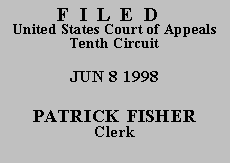

| DENZIL E. PLACKE,
Plaintiff-Appellant, v. KENNETH S. APFEL, Commissioner of Social Security Administration, Defendant-Appellee. |
|
Plaintiff appeals from a district court judgment affirming the Commissioner of Social Security's denial of his application for disability benefits. We review the district court's order de novo. See Brown v. Callahan, 120 F.3d 1133, 1135 (10th Cir. 1997). To that end, we must independently determine whether the Commissioner's decision is both supported by substantial evidence in the record and free of legal error. See id. Substantial evidence is "such relevant evidence as a reasonable mind might accept as adequate to support a conclusion." Richardson v. Perales, 402 U.S. 389, 401 (1971) (quotation omitted). Guided by these standards, we affirm.
As an initial matter, we repeat the magistrate judge's admonition that plaintiff's attorney should be aware of the requirement set forth by this court in James v. Chater, 96 F.3d 1341, 1343-44 (10th Cir. 1996), that all issues not brought to the attention of the Appeals Council are waived. We agree with the magistrate judge that plaintiff's communication to the Appeals Council shows that plaintiff focused on the step-four issue, at the expense of plaintiff's other issues. However, like the district court, we will consider all issues in this appeal.
Plaintiff was sixty-one years old when he applied for benefits, and he alleges disability because of carpal tunnel syndrome and various other problems in both wrists and lower back problems. Following the five-step evaluative sequence, see Williams v. Bowen, 844 F.2d 748, 750-52 (10th Cir. 1988), the administrative law judge (ALJ) made a determination at step four that plaintiff could perform his past relevant work as a medical technician. Plaintiff argues three points on appeal: the ALJ did not accord proper weight to his treating physician's findings and opinions; the ALJ's analysis and findings regarding plaintiff's pain and credibility were in error and not supported by substantial evidence; and the record does not contain substantial evidence that plaintiff can perform the demands of his past relevant work.
We do not agree with plaintiff that the ALJ erred in his weighing of the treating physician's opinion. In fact, the ALJ accepted Dr. Hathcock's opinion that plaintiff had a consistent limitation of not being able to engage in frequent repetitive motion actions. The record shows that Dr. Hathcock's findings and opinions are consistent with the ALJ's findings. The ALJ did not disregard the opinion of plaintiff's treating physician, and, in fact, his determination is consistent with the record evidence by the treating physician.
In addition, the ALJ properly considered plaintiff's subjective complaints of pain. See Luna v. Bowen, 834 F.2d 161, 165-66 (10th Cir. 1987). He correctly determined that nothing in the record indicated that, given the limitation of only infrequent repetitive motion activity, plaintiff could not meet the demands of his former work. The record indicates that plaintiff takes only aspirin for his pain, that he has not sought further treatment, and that his daily activities are consistent with the ALJ's findings as to plaintiff's capacity. The ALJ was within his province in finding that plaintiff's complaints of pain were not credible to the extent they were inconsistent with this record evidence and the medical evidence. Substantial evidence also supports the ALJ's finding that there was no objective medical basis for his complaints of back pain.
As to plaintiff's final argument, we hold that the record contains substantial evidence to support the ALJ's finding that plaintiff's impairments did not prohibit him from performing his past work, with the limitation that he only infrequently engaged in repetitive motion activity with his hands. In addition to being consistent with Dr. Hathcock's findings, the ALJ's conclusion is supported by the record evidence of Dr. White's consultative exam and Dr. Ellis's one-time exam. The ALJ questioned the vocational expert as to plaintiff's ability to perform the demands of his previous work as a medical technician, specifically instructing her to assume the limitation regarding repetitive motion activity. The expert testified that, given that limitation, plaintiff would be able to perform his former work as a medical technician. Finally, contrary to plaintiff's representation, the vocational expert did not testify that plaintiff would need to make a significant vocational adjustment to return to his medical technician work. She testified that plaintiff would need to familiarize himself with new medical equipment, but she did not testify that a significant adjustment would be required.
The judgment of the United States District Court for the Eastern District of Oklahoma is AFFIRMED.
Entered for the Court
Circuit Judge
*. This order and judgment is not binding precedent, except under the doctrines of law of the case, res judicata, and collateral estoppel. The court generally disfavors the citation of orders and judgments; nevertheless, an order and judgment may be cited under the terms and conditions of 10th Cir. R. 36.3.